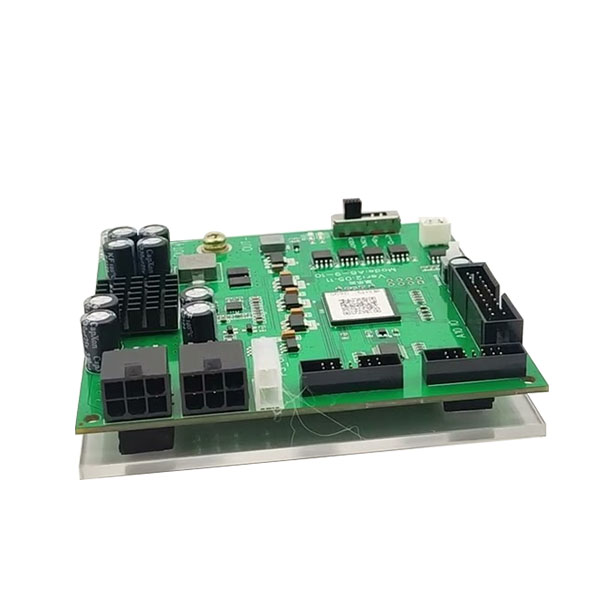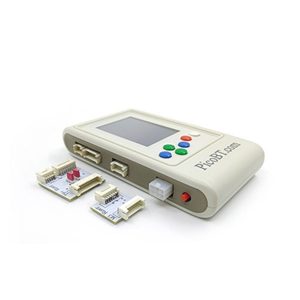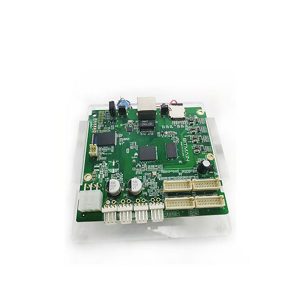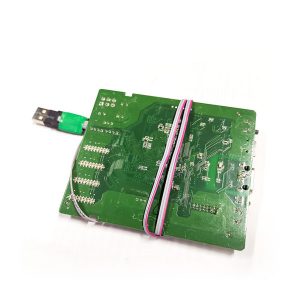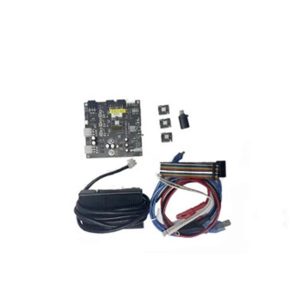Avalon 8 9 Series Test Fixture
* The actual quotation price may vary according to the market. Display price for reference only.
$400.00
Description
Avalon 8 9 10 test fixture / Avalon tester for A8 series / Avalon test stand
Avalon 8/9/10 Series Test Stand For testing Avalon miner A821 A841 A851 A852; A920 A921; A910 A911; A1066 A1047 (Note: A1066Pro cannot be tested with this fixture) hash board ASIC chip status, Help us find which area is the ASIC chip damage and find the problem more intuitively can fix the hash board accurately and quickly. Please read the following introduction carefully before using this jig. Improper operation can easily cause the jig and hash board to burn out.- White LED light: Indicates whether there is an output power supply; if the light is on, it means there is the output voltage, and if the light is not on, it means there is no output voltage.
- OUT+ (red clip): output positive, there are two voltages 10V and 12V, how much voltage is output is controlled by the mode switch. A8* and A9* series are both 10V output, and A10* series are 12V output; before the clip is connected to the board, be sure to confirm whether the model and model switch is switched correctly. OUT- (black clip): negative output pole.
- LED2 (green LED): Indicates that the board has passed the test and no maintenance is required.
- LED1 (red LED): indicates that the test board is not good and needs to be repaired; the specific problem still depends on the LOG, and some problems can be ignored.
- Gear switch: a total of 4 gears, the main output voltage is controlled by this switch. The gear models are: First gear A841: A821 / A841 / A851 / A852 Second gear A920: A920 / A921 Third gear A911: A910 / A911 Fourth gear A10: A10 series (Note: A1066Pro cannot be tested with this fixture)
- White 2PIN interface, serial output of the first and second gears, pin 11 is GND (black cable), and pin 12 is RX (white cable).
- Yellow 2PIN interface, serial output of the third and fourth gears, pin 9 is GND (black cable), and pin 10 is RX (white cable).
- A10 IO: A10* data cable interface, connected to A10* data cable interface of hash board.
- Self-locking switch: Press this switch when you want to maintain and check the signal, the board signal (for example, the C signal will have a high level of one chip and a low level of the chip) will be output regularly, which is more convenient when measuring signals; normal test board When it is good or bad, this switch should be turned on, otherwise there will be no output from the serial port.
- A8-9 IO: The first and second gear data cable interface, connected to the A8*-A920/A921 hash board data cable interface after passing through the adapter board and the cable.
- A911 IO: The data cable interface of the third gear is connected to the data cable interface of the A910/A911 hash board after passing through the adapter board and the cable.
- PS_ON: Connected to the foot switch, press it to supply power immediately, release it to power off immediately. It is recommended that the continuous pressing time does not exceed 3 seconds. When the continuous pressing time reaches 6 seconds, the fixture will also automatically power off to prevent the hash board from overheating.
- IN(12V): The 12V output from the PC power supply is connected here to supply power to the fixture, and both interfaces must be connected well.
- Adapter board: A8*-A9* universal adapter board for cables, connected to the jig, and connected to the hash board via 2*7 cables. (Note: the colored side of the cable is connected to the first pin of the hash board)
- The USB to the serial port is connected to the computer, and the fixture end is connected to the white or yellow interface according to the gear.
- Open the software to install the serial port driver; if it has been installed, you can ignore this step.
- Open the serial port software, select the corresponding COM* for the serial port number (you can view the serial port number in the device manager), and select the baud rate as 115200.
- Turn the switch to the corresponding position according to the model.
- The 6PIN output of the PC end is connected to the input port of the fixture.
- Connect the foot switch interface to PS_ON, and put the switch on the ground to control the power supply with a foot pedal.
- Connect the cable to the fixture according to the model.
- Connect the output power supply to the power supply of the hash board, first connect – and then +. (Note: If the positive and negative poles are reversed, it is easy to burn the jig and hash board)
- Connect the cable to the cable interface of the hash board. (According to experience, this step must be connected before stepping on the electricity)
- Step on the foot switch; the test result will be displayed in 2 seconds, one red/green LED will light up, and there will also be a Log display on the serial port software. After the test result comes out, release the foot switch (it is recommended that the continuous pressing time does not exceed 3 Seconds, when the jig is pressed continuously for 6 seconds, it will also automatically power off to prevent the hash board from overheating).
- The gear switch must be the correct model.
- The connection between the jig and the board must be correct, and cannot be misplaced or reversed.
- The board to be tested cannot have abnormal short circuit, and the main power supply can be measured with a multimeter; A10: Is the resistance value of the 6 data signals (DI, RI, CI, DO, RO.CO) of the data interface abnormal; A8-9 : Is the resistance value of 6 data signals (DI, RI, CI, DO, RO.CO) and 2 power supply (1.8V, 12V) of the data interface abnormal.
If your preferred payment method is Offline Payment or Wire Transfer, please get in contact with DogeMiner team via email or online chat so we can assist you further with the order placement.
Offline Payment
USDT TRC20 Last Six Characters : Address①UmfjCL ;
Shipment
Please read all terms of shipment and payment before placing your order.
DogeMiner has two warehouses, Shenzhen warehouse and Hong Kong warehouse. Our orders will be shipped from one of these two warehouses.
All mining products include postage; some products do not include postage, such as miner parts, immersion cooling system and mobile mining, if you need to place an order please contact us to account for your shipping costs.
1 – Packaging details: carton packing / per unit
2 – Worldwide delivery(Customer Request Acceptable): UPS, DHL, FedEx, EMS, TNT and Special Express Line (double-clear tax lines and door-to-door service for countries such as Thailand and Russia)
3 – Port: Shenzhen / Hong Kong
4 – Lead time: in 7 days after payment
Note: If you have any questions about the logistics information, please contact us immediately. We will track your shipment and get back to you as soon as possible.
| SHIPPING COMPANY | ESTIMATED DELIVERY TIME | PROCESSING TIME |
| Fedex | 3-7 days | 3~7 business days |
| UPS | 4-8 days | |
| TNT | 3-8 days | |
| DHL | 3-7 days | |
| EMS | 5-15 days | |
| DPEX | 3-6 days | |
| Aramex | 3-9 days | |
| Russia Express-SPSR | 14-25days |
Refunds
All items are non-refundable and orders not cancelable. (Except in the case of damage and defects as specified in the product warranty)
You will be responsible for paying for your own shipping costs for returning your item. Shipping costs are non-refundable. If you receive a refund, the cost of return shipping will be deducted from your refund.
Depending on where you live, the time it may take for your exchanged product to reach you, may vary.
Warranty
PROTECTION
This warranty is non-transferable and is enforceable only by the original purchaser. Any product that has not been purchased as new and/or from us is expressly excluded from this warranty.
We shall not be responsible for any incidental or consequential damages incurred and/or occurred in connection with the product or its purchase. Our responsibility is limited solely to the product itself. We assume no responsibility for any loss or costs due to third party’s or customer’s loss of profit, or any other indirect cost or losses however incurred.
Additional non-returnable items:
Antminer’s Mining Hardware, Halong Miner’s Hardware, Innosilicon’s Mining Hardware, Baikal’s Mining Hardware, Dayun’s Mining Hardware.(Except in the case of damage and defects as specified in the product warranty)
WARRANTY LIMITATIONS
We offer no warranty for pre-installed software, its quality, performance, functionality, or compatibility for a particular purpose. We do not warrant that the functions contained in the software will meet specific requirements or that the operation of the software will be uninterrupted or error-free. The product is sold “as is”.
To the extent permitted by applicable law, this warranty does not apply to:
normal wear and tear;
damage resulting from accident, abuse, misuse, neglect, improper handling or improper installation;
damage or loss of the product caused by undue physical or electrical stress, including but not limited to moisture, corrosive environments, high voltage surges, extreme temperatures, shipping, or abnormal working conditions

